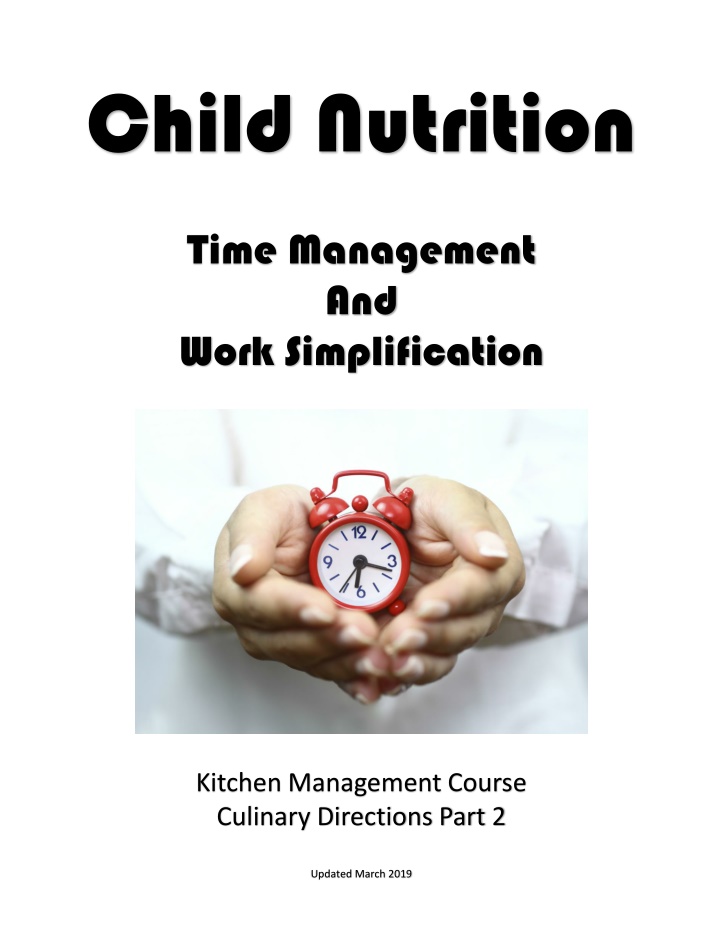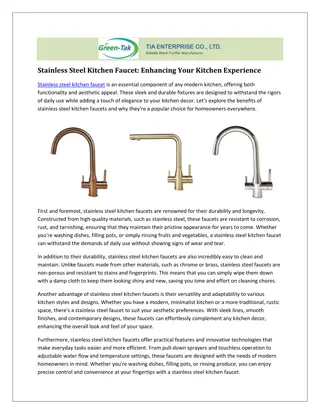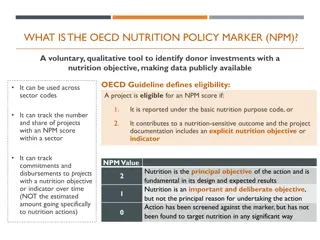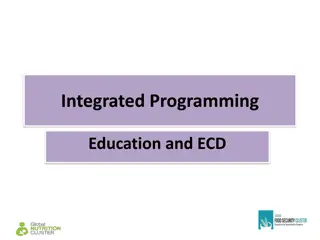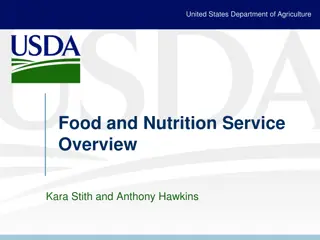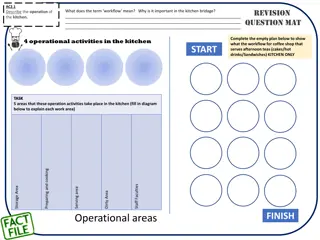Efficient Kitchen Management for Child Nutrition Professionals
Child nutrition professionals play a critical role in ensuring students receive tasty, nutritious meals. This comprehensive kitchen management course emphasizes the importance of work organization, cost savings, and efficiency in school kitchens. Participants learn techniques to streamline work, optimize resources, and enhance productivity to deliver high-quality meals. Practical activities and insights empower professionals to improve their kitchen management skills and enhance the overall school food service experience.
Download Presentation

Please find below an Image/Link to download the presentation.
The content on the website is provided AS IS for your information and personal use only. It may not be sold, licensed, or shared on other websites without obtaining consent from the author.If you encounter any issues during the download, it is possible that the publisher has removed the file from their server.
You are allowed to download the files provided on this website for personal or commercial use, subject to the condition that they are used lawfully. All files are the property of their respective owners.
The content on the website is provided AS IS for your information and personal use only. It may not be sold, licensed, or shared on other websites without obtaining consent from the author.
E N D
Presentation Transcript
Child Nutrition Time Management And Work Simplification Kitchen Management Course Culinary Directions Part 2 Updated March 2019
Introduction Introduction Child Nutrition Professionals - whether a director, manager, or kitchen staff - work to prepare tasty, nutritious, and safe meals for their students. To ensure the best quality meals are served in schools, kitchens must effectively manage time and simplify their work. The following manual teaches the principles of time management and work simplification as they relate to school food service and the United States Department of Agriculture Child Nutrition Programs. After participating in the Kitchen Management Course, participants will be able to: Describe the importance of work and personal organization Explain cost savings in a well managed kitchen Design work, cleaning, and equipment schedules Demonstrate techniques for simplifying work In the sections and activities ahead, new Child Nutrition Professionals will have the opportunity to evaluate their current kitchen management practices and to develop an action plan for improving the time management and work simplification skills of their school kitchen.
Work Organization Work Organization The first step in managing a successful school kitchen is to organize the work. Work organization helps to achieve work with the greatest efficiency, maximum economy with minimum effort, and secure the personal development of those working in the organization. Advantages to Work Organization: Labor is more efficiently used; Equipment is used efficiently; Labor hours are more productive; Responsibilities and the workload are more evenly divided; Employees have a better understanding of their duties; The operation is run more efficiently; The employee develops a sense of security and pride; There is less change of a job begin left incomplete; and, There is less pressure and strain. What other advantages can you think of?
Project 1 Project 1 Look at this example of how work organization can improve outcomes even in a home kitchen. In the space below, roughly sketch the kitchen in your home. Identify where you currently store the ingredients and equipment needed to make coffee and draw the path you follow while making coffee. (Consider using a red pen to draw the path)
Project 1 Project 1 Now consider how you could better organize the work that must be done in your home kitchen to make coffee. Draw another rough sketch of your kitchen at home. How could you decrease the amount of space between your cups and your coffee pot? Are you running back and forth between the counter and the refrigerator to get creamer? Where is the sugar in relation to where you place your coffee cup on the counter? How can you make coffee more efficiently in your kitchen with small changes?
Cost Savings Cost Savings The second step in successful school kitchen management is to consider cost savings. Cost savings is the reduction of business expenses and is important to Child Nutrition Programs because meals are reimbursed at a specified amount. That amount must cover food, labor, and indirect costs. Child Nutrition Professionals must look at current policies and procedures that potentially increase costs and consider ways they can improve cost savings. With increasing food costs, labor costs, and other expenses, the Child Nutrition dollar is being stretched further than ever. Food cost is not the only criteria that schools must look at to find a source of saving money. One place school kitchens can look for cost savings is in their management of time. After all, TIME IS MONEY. Saving Money by Time Management The exercise on the next page will help you to see how labor dollars can be lost in a variety of ways. Often the person wasting them is not even aware that it is happening.
Project 2 Project 2 The following are kitchen employees at Anywhere Public School. They are considered to be good and conscientious workers. Their supervisors think highly of them. Sometimes they feel overworked. But they do not mind. They like their jobs, and they feel they do their best for their district. None of them feel they could ever be accused of wasting district labor dollars. But they do. Certainly not on purpose. But they do just the same! George arrives 15 minutes late or leaves 15 minutes early almost every day. Jane gets a 10 minute phone call from her son every afternoon. Ann never learned to assemble the slicer, so she has Jane do it for her. It takes Jane 15 minutes each day. (Ann s work is being done, but Jane s time is wasted. Bill incorrectly read the production sheet and made only half the number of serving of lasagna needed. It took Bill and extra hour to make the additional servings. Frank supplies other workers with ingredients and supplies. He often finds it easier to make several trips instead of using a tray or cart; extra time for trips across the kitchen = 30 minutes. Ann baked the chicken on sheet pans and then transferred it to steam table pans; transfer time = 30 minutes; washing pots for Mary = 1 hour. Betty spent 30 minutes writing production sheets for the week before she discovered the menu had been changed.
Project 2 Project 2 Employee Hourly Wage Lost Minutes per Day Dollars Lost per Day Total (178 days) George 8.50 Jane 9.00 Ann 9.00 Betty 9.25 Mary 8.50 Bill 8.75 Frank 10.00 TOTALS What other ways have you seen labor dollars wasted? What other ways could the dollars saved be used to improve your Child Nutrition Programs?
Personal Organization Personal Organization In addition to work organization, personal organization is important to the success of school kitchen. Child Nutrition Professionals who are organized improve the overall effectiveness of the school food service program. Steps for organizing work: 1. Know and observe rules for safety and sanitation; 2. Understand assignment; 3. Check recipe adjustments; 4. Assemble supplies; 5. Assemble needed equipment; 6. Plan for progress of work; and, 7. Allot time required for preparation. Factors to consider before beginning job assignment: 1. What items are to be prepared? 2. How much of each item is needed? 3. What is the portion size? 4. Which recipe or method of preparation is to be used? 5. What time is the food to be served? 6. How will the food be served? 7. Where is food to be taken for service or holding? Procedures for assembling supplies: 1. Use a tray or cart to assemble supplies. 2. Make one trip to storeroom for dry goods. 3. Make one trip to cooler for perishable foods. 4. Roll food bins to area of preparation. Examples: flour, sugar, meal, and powered milk (note: Always use opened containers before opening new ones.) Do you take time to organize in the kitchen? In your office?
How to assemble needed equipment 1. Collect all needed small equipment. 2. Arrange for use of large equipment. a) Coordinate with other departments using the same piece of equipment. b) Discuss with other departments the length of time needed for each piece of large equipment. (Note : Searching for equipment during preparation disrupts the work flow and increases the likelihood of error and time loss.) Procedures used to plan for progress of work 1. Place items where they will be used by the hand that picks them up. 2. Place items where other things will not have to be moved to get to the item required. 3. Keep work station arranged in a neat and orderly manner. Allotting the time required for preparation: 1. Prepare foods first that require the longest production time. 2. Make a schedule of time using service times and work backwards. 3. Avoid preparing so far in advance that the quality is lost. The work schedule is critical for maintaining food holding temperatures. 4. Organize work schedules for that adequate time can be given to each item. 5. Complete all foods at the time desired.
Work Schedules Work Schedules One of the best tools for successfully managing a school kitchen is a work schedule. The work schedule is a detailed listing of duties to be performed by an individual. Schedules should be developed cooperatively by the manager and workers. They should be revised and updated regularly, and the work schedule should be flexible and personalized for specific programs. A. The Purpose of Work Schedules is: 1. To organize work. 2. To delegate duties and responsibilities. 3. To eliminate wasted time and motion. 4. To provide improved standards. 5. To train personnel. The Advantages of Work Schedules Include: 1. Eliminates controversy over duty responsibility. 2. Distributes work load. 3. Simplifies instruction. 4. Eliminates confusion. 5. Designates job responsibility. 6. Designate completion time. 7. Assures that meals will be prepared on time. Factors to consider when planning a work schedule are: 1. Employee input. 2. Number to be fed each day. 3. Menus for required pre-preparation. 4. Labor per hour needed. 5. Available personnel. 6. Skill of employee. 7. Daily, weekly, and monthly cleaning. 8. Available equipment. 9. Food preparation area. (size, equipment, etc.) 10. Policies and procedures of the school. (offer verses serve, breakfast program, etc.) B. C.
How to Develop Work Schedules 1. Make a job inventory; divide the tasks into various work units. a. Request each worker to list all activities performed during the day including length of time required for completion. b. Evaluate job inventory with the employee. Assign each job to a specific person to be responsible for its completion. Assign each person to a specific unit, such as salads or bake units. Consider overlapping jobs. Example: Prepare lettuce cups for hamburgers needed the following day while making salad. Allow for joining of tasks whenever possible. Example: If the baker is doing rolls for lunch and has cookies to do for the following day, a. The baker might consider weighing the flour for both recipes at the same time. This might eliminate storeroom trips and getting scales out twice. b. While cookies are in the oven, the baker should clean the baking area, mixer, etc. Plan for pre-preparation whenever possible. This can allow time for emergencies and other problems that might arise like late deliveries, absent employees, etc. Plan a reasonable time schedule during which the employee can be expected to complete the job. State in each work schedule the duties involved in preparation, service, and clean up. 2. 3. 4. 5. 6. 7. 8. Notes: A. The ultimate work schedule, whether it is an individual or unit schedule, will have Time allotted for the task and Specific recipes to be used listed. Workers need to be able to plan their own work schedules if the manager does not give them one. Always start with the serving time (deadline for a product to be ready) and work backwards. Don t start cooking at 8:00 a.m. and have lunch ready (completely cooked)by 9:30 a.m. if serving time is not until 11:00 a.m. B. C. D.
Types of Work Schedules Types of Work Schedules 1. Individual a. A best practice when having individual schedules is practical. b. Recommended for new employees or when many changes are made in daily procedure. c. See Individual Work Schedule examples. 2. Daily a. b. c. A best practice for most school kitchens. Usually applicable with limited number of employees. See Daily Unit Work Schedule examples. 3. Organization a. A best practice for large operations with specialized employees performing the same functions daily. b. Most effective in school kitchens where individual assignments made daily. c. Cleaning schedules are a specific type of Organization Work Schedule. Small and large operations should develop cleaning schedules that list specific job duties to be performed. d. See Kitchen Cleaning Schedule example. 4. Equipment a. The cost of the equipment per unit produced should be as low as possible to cut the total cost od the operation. Stagger use to allow more than one production unit to use the same equipment. b. To efficiently utilize equipment: Plan the menu Refer to the recipe card and management experience for timing. Make a schedule for the time needed for each piece of equipment for each menu item. Correlate this with the personnel work schedule. Organization of an equipment schedule. See Equipment Schedule .
Individual Work Schedule Example Position: Main Dish Cook Hours: Responsibilities: You are responsible for preparation of the main dish and the completion of all duties necessary in your department. 1. Sign in each day. 2. Read menu and work sheet. Study recipe ahead of time so you can be organized efficiently. 3. Gather supplies from storeroom, freezer, or refrigerator and take to work area. Use cart, portable table, or tray to gather supplies. This will save TIME, ENERGY, AND STEPS. 4. Prepare main dish item, such as meats, gravies, and sauces. 5. Place completed product in hot or cold storage for holding. 6. Look ahead, make sauces, salad dressings, etc. as needed. 7. Keep pots and pans washed as you work as well as the mixer, food slicer, and any other equipment used. Tools and equipment will then be ready for use by next person and time will not be wasted. 8. Keep you work area tidy and clean as you work. 9. Store, label, and date leftovers. List and give to the manger. 10. Do pre-preparation according to menu. 11. Keep assigned portion of refrigerator and freezer clean and neat at all times. 12. Use freezer, refrigerator, and storeroom check out sheets for each item taken out or returned. Keep up to date. 13. As time permits, help others. 14. Leave work area clean. Straighten drawers, clean shelves, tabletops, and storage bins. 15. Sign out at the end of the day. Initial time sheet at the end of the week. These are your direct responsibilities, but you are to help where needed. There are days when your preparation gives you time to help others and helping each other makes the day s work easier to complete. No one is through until all are finished. Manager Signature
Individual Work Schedule Example Schedule for: Position: Serving Time: Menu: Hamburger on bun Tater tots Lettuce and tomato salad Hours: Date: Assorted Fruit Milk Frosted Cake Time Preparation Number To Prepare For Recipe Directions 8:00 Prepare cake 250 C-20 2 X recipe 9:00 Clean area 9:30 Coffee Break 9:40 Make frosting C-18 2 X recipe 10:15 Wash pots and pans 10:30 Cut cake and frost 11:00 Set up line with desserts 11:20 Serve on line 11:30 Serve on line 12:00 Put fruit in refrigerator for tomorrow 4 cans fruit cocktail 3 cans sliced peached 2 cans USDA pineapple tidbits 12:30 Check next days schedule 12:45 Clean milk cooker
10:45-11:15 10:30-10:45 10:00-10:30 9:30-10:00 9:00-9:30 8:30-9:00 8:00-8:30 7:30-8:00 Time Daily Unit Work Schedule for 4 Personnel Kitchen Lunch Period Chef Salad Help cut up salads Help with Main Dish Record Keeping rise ingredients for bread, let Mix pre-weighed schedule and records Open Kitchen, organize Manager 7 hrs. Lunch Period fried chicken tomorrow Prepare bread crumbs for Bake bread Prepare Main Dish 6 Hr. Assistant Morning Example Set up trays and utensils Help with Chef Salad Cut up vegetables for salad Wash vegetables for salad Punch down and pan bread 5 Hr. Assistant Help set up line dishes. Mix salad for lunch. Set up line- napkins, straws, and refrigerate Dip up chilled fruit and 4 Hr. Assistant
2:30-3:00 2:00-2:30 1:30-2:00 1:00-1:30 12:30-1:00 12:00-12:30 11:30-12:00 11:15-11:30 10:45-11:15 Time Daily Unit Work Schedule for 4 Personnel Kitchen Check next day schedules Prepare reports; Place orders tomorrow and put in refrigerator for Take topping out of freezer Help clean tables Count money Back up line or serve Back up line Back up line Put food on steam table Lunch Period Manager 7 hrs. Check next day schedules Help with kitchen cleanup Clean steam table Put away food Cashier Cashier Serving; set up for next line Put food on steam table Lunch Period 6 Hr. Assistant Afternoon Example check next day schedules Clean tables Help in dish-room Serving; help in dish-room Serving; set up for next line Cashier Put on desserts 5 Hr. Assistant Check next day schedules Help with kitchen cleanup Clean dish-room Dish-room Dish-room Serving Serving Wash pots and pans 4 Hr. Assistant
Kitchen Cleaning Schedule Jobs to be done Daily Weekly Monthly or as needed to keep clean Bake tables Clean thoroughly Clean legs and inside drawers Dishwasher Clean scrap tables, hose inside, wipe outside, remove and clean. Wash and rinse arms and curtains, air dry De-lime, if necessary Drawers in all tables Remove all objects and sanitize Fans Remove grease and dust Floors Mop Scrub Filters Wash Freezer Straighten, wipe up spills Rotate stock, clean shelves Wash shelves, defrost Garbage area Hose and scrub Garbage pails Scrub inside and out Hood Wipe clean As needed to keep clean Light fixtures As needed to keep clean Loading zone Sweep and hose Milk cooler Wipe inside and out Mixer Clean thoroughly Oven Wipe inside and out Clean thoroughly Clean burner compartment of stack ovens Pan rack Clean thoroughly Clean casters, legs Range Clean thoroughly Clean thoroughly Clean casters, legs Refrigerator Wipe spills immediately, clean outside and top Take everything out, wash thoroughly Defrost Refrigerator (walk-in) Straighten and wipe up any spills Mop floor, wash inside and out Wash inside and out Defrost Restroom Clean fixtures and floor Serving counter Clean thoroughly including sneeze guard Sink and under plumbing Clean sink Clean under pluming Steamer Clean compartments Blow down boiler more often if used constantly Manually clean boiler Tilting braising pan Clean after each use Walls and woodwork Clean as needed Wash as needed to keep clean Windows Clean as needed Wash as needed Work tables Wipe aster each use Clean all surfaces As needed to keep clean
Equipment Schedule Fill in the time each piece of equipment should be used for each item of the menu. Use menu on individual work schedule. Menu Ovens Steamer Kettle Range Mixer
Project 3 To practice developing work schedules, think about your own daily assignments and record the time frame (8:00 8:30, for example) in the first column and the specific job duty in the second column. Consider whether individual work schedules or daily work schedules are more practical for your school kitchen. Discuss with the class. Time Manager _____ Hours What other work schedules would be helpful in your school kitchen?
How to Increase Productivity by How to Increase Productivity by Working Smoother Working Smoother Increasing productivity allows a successful school kitchen to increase the amount of meals served without increasing costs. More meals means fewer hungry students and increased reimbursement for the school. Child Nutrition Professionals working in the school kitchen can increase productivity by simply working smoother. Simply stated, Working Smoother is the process of making a job easier through the proper use of the human body and the arrangement of the work area. Working smoother means that a job can be done more easily, simply, quickly, and safely. It may mean changes in the arrangement of equipment or work procedures. But either or both changes should result in higher quality products and standards with less fatigue on the part of the worker. 1. Work comfortably: Wear comfortable clothes and shoes. Get plenty of light and proper support for the back and feet. Adjust chairs and tables for comfortable work heights. 2. Avoid excessive body strain: Limit weight load to 35 - 50 pounds. Bend knees to lift heavy objects. Push or pull instead of lift or carry. 3. Develop a steady pace: Working too fast (like driving too fast) uses up too much energy. Individuals work at different speeds. Consideration should be given to the outcome of work and the time required to complete the work. 4. Take approved resets: Avoid energy drain by resting between big jobs. Restore energy by approved rests between work periods. Get plenty of rest between work shifts. 5. Make motions economically: Use both hands in unison, starting and stopping together. Use symmetrical arm movements in opposite directors. Use continuous curved movements. Use momentum and drop delivery. 6. Confine work to normal and maximum work centers: Keep tools and materials within easy reach. Use assembly line techniques. Use mobile centers.
Work Simplification Work Simplification Work simplification is the study of tasks and operations to determine the most efficient way to do a job. Such study can cut down on the drudgery and routine of jobs, thus allowing more time for skill and satisfaction in the assembly of the finished product. Principles, techniques, information, and implementation can guide the wise use of Child Nutrition Professionals time. The goal is to produce more efficiently with less fatigue to the worker. Workers fatigue is often expensive as it causes deterioration of quality, spoilage and accidents. It also causes lowered capacity for work. Work simplification can be achieved by working smarter. 1. Select the job: It isn t difficult to choose a job or part of a job to be improved. Just look for bottlenecks that slow things down. Also take a look at jobs that seem to require a lot of running about. An important point to remember when choosing a job for improvement is that every job has three parts: make ready, do, and put away. Every worker spends time and effort getting ready to do the job. The do part is actually performing the job. It is the part that changes and adds value to the product. Put away is just that the disposal, cleaning, storage, etc. that follows every do operation. The make ready and the put away add nothing to the value of the product so jobs that require a lot of preparation and cleanup are good candidates for improvement. Example: Making cookies Get supplies, etc.; Make the cookies; clean-up 2. Get all the facts: The second step, getting the facts about the job, can be done in several ways. One could be making a simple written list of all the steps involved.
3. Challenge the facts: After getting a written list or chart, begin to challenge. Ask the question Why? Why is the job being done at all?. This may seem like a long shot, but it is worth asking. The entire job may be eliminated. For example: If someone is still taking time to wrap the silver, one could ask the question, Why are you still wrapping silver? . The answer might be, That s the way we ve always done it. This job could be eliminated. Some other Whys that might be asked are: 1. Why is the job done in that place? 2. Why is it being done at that time? 3. Why is it assigned to that person or position? 4. Why is it done in that way? The last of these Ways may be the most productive; for, there is a better way to do most jobs . 4. The Why questions lead us into the most creative and positive step to go ahead and develop the better way. Eliminate details to get rid of useless or unnecessary work. Combine steps to make one operation do the work of one or two. For example peanut butter and other ingredients could be mixed and spread in one operation. The cinnamon roll filling, of butter, cinnamon, and sugar, is another example where items could be combined and used at one time. Rearrange details to shorten procedures to avoid duplication or backtracking. Simplify the details that are left to make the job easier and quicker to do. For example biscuits that are cut in the pan into squares or triangles instead of circles, taste just as good. But this operation is more efficient because there is no need to handle them and re-roll and cut out additional biscuits. There are a great many jobs that can be improved by Rearranging, Eliminating, Simplifying, and Combining. These are the techniques that can save Time, Steps, Energy, and Money! They should be done continuously and consciously.
Work Simplification Work Simplification Through the Organization and Use of Through the Organization and Use of Work Station or Centers Work Station or Centers What is a work station? A work station is an area in which one it more employees perform a series of similar tasks. In a small operation, a work station may be dual purposed. In large operations, work stations may become very specialized. A work station should contain: 1. Some of the ingredients and supplies most commonly used. 2. All small equipment necessary to perform the assigned duties or tasks. 3. Large equipment commonly used, or easy access to such equipment. How can a kitchen be organized into work stations? The following factors should be taken into account before decisions are made on work stations: 1. Menus 2. Existing Facilities 3. Work Schedules What are the best locations for work stations? 1. Consider the frequency of use of dry, cooler, and freezer storage areas. 2. Consider the frequency of use of the large, fixed pieces of equipment. 3. Consider the locations of sinks and garbage disposal units. 4. Consider the flow of ingredients and supplies. The first step in organizing your kitchen is to look at your menus, existing facilities, and work schedules to determine which work stations your particular operation needs, then select the more appropriate location for each of the work stations.
Project 4 Project 4 Remember that equipment and materials should be placed in an established location a work station or center. Using this principle, list what you would include in Baking Center and Serving Area. Baking Center 1. 2. 3. 4. 5. 6. 7. 8. 9. Serving Center 1. 2. 3. 4. 5. Does your school kitchen have effective work stations? How could you improve?
Work Simplification Work Simplification While Serving the School Meal While Serving the School Meal Serving the meal to your students is the highlight of the work day. However, meal service can also be frustrating, time-consuming, and energy absorbing. How can serving time be simplified? Meals should not be pre-plated before students come through the line. Pre-plating is NOT a time saver or a safe food practice. Quality and sanitation are primary factors to consider in any time-saving plan and must be given top priority. Food, when pre- plated, will lose its quality - hot foods may get cold and cold foods become warm. Factors to consider when setting up a serving line are: 1. A fast working person should start the service. 2. Easiest-to-serve items should be served with the less dominant hand. Harder to serve items should be served with the dominant hand. (example a right handed person should serve the roll with left hand and cream potatoes with the right hand.) 3. Harder to serve items should be located in the middle of the line. 4. The last person in the line who slides the tray to the student should not have a serving tool in the hand which is to slide the tray. A right handed person would be positioned to work more with the right hand. A left handed person could slide a tray to the left. 5. Always provide the correct serving tool and disposable gloves for the serving line. The correct serving tool ensures Meal Pattern requirements are met, and easy-to-access gloves ensure food is handled safely. 6. Do not touch the eating surface of the tray.
Work Simplification Work Simplification Through the Use of Standard Body Movements Through the Use of Standard Body Movements Standard Motions Child Nutrition Professionals should be able to accomplish their work with as little fatigue as possible. Staff do their best work when following these suggested body, hand, and figure motions: 1. Avoid unnecessary reaching, stretching, and bending. 2. Use both hands when possible, starting and completing motions at the same time. Example: Putting rolls on a pan. 3. Form habits by continual use of correct motions. 4. Move arms in opposite and symmetrical directions and simultaneously, rather than in the same direction. 5. Use simple, balanced, continuous, and rhythmic hand motions. 6. Distribute hand and body motions. a. Finger motion b. Finger and wrist c. Finger, wrist, and lower arm d. Finger, wrist, and upper arm e. Finger, wrist, arms, and body 7. Make use of momentum, acceleration, and gravity to accomplish tasks. 8. Avoid sudden sharp stops. 9. Use curved rather than straight line motions involving sudden and sharp changes in direction, especially on long processes.
Work Simplification Work Simplification Through Using Wheels Through Using Wheels Wheels make them work for you. Tables, storage bins, pans, racks, hot and cold cabinets, mixer, dollies, storage dollies, mop buckets, etc. all on wheels save time and energy use them. 1. The utility cart, dish truck or portable table can be your most versatile piece of equipment for saving steps and increasing efficiency. 2. A strong utility cart can be used as a receiving table for checking in small items and then transporting them to storage or points of use. 3. Use the cart to bring supplies from the storeroom for the whole day rather than making several trips. 4. Use a cart to take cooked food to the serving line instead of making several trips with separate items. 5. Use bins on casters for flour, sugar, cornmeal, salt, dry beans, dry milk, etc. 6. Use a cart to take case goods from storeroom to point of use, but be sure not to overload a light weight cart. 7. Use a portable table or cart to hold pan or bowl when using shredder or great attachment on mixer. 8. Use the cart to remove pans from serving line after serving. 9. Use the cart to transport clean trays from dish room to serving line. 10. Put baker s scales on a portable cart. 11. Use a portable table for meat slicer. 12. Be sure the wheels on carts are cleaned and oiled regularly.
Work Simplification Work Simplification by Use of the Proper Tools by Use of the Proper Tools Equipping a kitchen with the proper tools is essential for the labor efficiency of the operation. However, the tools are of no value unless the following three conditions exist: 1. The tool must be readily available to the workers who needs it. 2. The worker must be aware of the various uses for the tool. 3. The worker must be trained in the use and care of the tool and feel confident in his/her skills in using the tool. Tools can help cut time, motion, and the labor costs of an operation. 1. Carts and trays used for gathering needed ingredients, supplies, and tools reduce the amount of time spent walking through the kitchen. 2. Recipes should be written so that the most convenient method of measuring is used. Example: 4 Tbsp. should be measured as c. 3 qt. should be measured as gal. 15 Tbsp. should be measured as 1 c. minus 1 Tbsp. Motion is wasted when a small measure is used many times instead of using a larger measure once. 3. A food slicer can be used for many jobs other than slicing meat and cheese. Slice refrigerator cookie dough, cabbage for coleslaw, lettuce for sandwiches, celery, carrots, and other vegetables. Carrots sliced thinly lengthwise will curl automatically and make a lovely garnish for a special salad. 4. A pan of vegetable oil and a pastry brush quickly greases baking pans. Do several pans at one time.
5. Do not cut anything in the hand that can be cut on a cutting board. Learn the uses for different types of knives and use the proper knife for the job. Make cutting motions count. Examples: Using a French knife, slice several celery stalks or carrots at once rather than one at a time. Using a slicing knife, slice two or more rolls of refrigerator cookie dough at once rather than one at a time. 6. Mark a yard stick clearly with commonly used portion sizes. Lay the stick along the pan and quickly, accurately mark the product for even portioning. Use a portion cutter if possible. 7. Use a dry vegetable brush to clean lemon and orange rinds from the grater before it is immersed in water. 8. Before using a machine for small jobs, evaluate whether or not the time needed to clean the machine, warrants the use. In some cases the job may be done more quickly with appropriate hand tools. 9. Child Nutrition Professionals should be alert to the use of gravity in making work easier. Drop deliveries should be used whenever possible. The cut-off for garbage in a drainboard is an example, but built-in equipment is not always necessary. Proper placement f cutting boards and pans in relation to each other will accomplish the same results. For Example: When chopping vegetables, it is easier to slide the prepared product off the cutting board into a pan which has been placed at a lower lever (such as, in a sink) than it is to lift the prepared product into a pan placed on the table or drainboard. Whenever possible, let gravity do your work! 10. Use a rubber scraper for removing food from cans and the containers. Not only is the job done more quickly but less food clings to the side of the container, which reduces waste.
Work Simplification Work Simplification Saves Energy Saves Energy Energy may be physical, mental, or emotional. Saving of that energy can mean the difference between going home exhausted at the end of the day and being able to enjoy the evening with family and friends. The following chart shows how much more oxygen we can consume per minute based on the activity in which we are engaged. Activity Height of reach above floor in inches Oxygen consumed per minute increase over standing still (percent) Arm reach 46 12 Arm reach 56 24 Arm reach 72 30 Arm reach and truck bend 22 57 Step up 7 inches 119 Arm reach and truck bend 3 121 This indicates that rearranging, simplifying, and planning out work can save much energy: physical, mental, and emotional.
Work Simplification Work Simplification with Regard to Work Environment with Regard to Work Environment The work environment has a great deal of influence on attitudes and on the productivity of workers. The following is a list of factors to be considered when evaluating an operation with regard to work environment: 1. Lighting Proper lighting is essential in lessening eyestrain, reducing fatigue, and avoiding errors. a. Older employees may require up to twice as much light in the work area than younger employees. b. Locate lighting so that sharp contrast in light intensity, spotty lighting, shadows, and glare are eliminated as much as possible. c. Do not place workers in area where they will be facing bright light. d. Fluorescent lighting is generally accepted as being more energy efficient and a higher quality form of lighting than incandescent lighting. Care must be taken in selecting fluorescent lightings in that some types change the color appearance of the food being prepared or served. 2. Color Studies indicate that the color of a room may have significant impact on the emotions od a person in the room. For example, some researchers indicate that certain shades of pink may produce hostile feelings in people exposed to this color for even a short period of time. Traditionally, light colored walls and ceilings in a dull, rather than a high gloss, finish are recommended for kitchens because of the light reflective values of the lighter colors.
3. Ventilation, temperature, and humidity Odors, heat, and excess humidity annoy workers and will lower worker productivity. a. Good ventilation provides clean, fresh air by removing smoke, odors, moisture, fumes, and grease vapors. b. The recommended temperature for a work area is 70-80 F. c. The recommended humidity level is 50-60 . Noise Control Excess noise in a work environment is irritating, distracting, and lowers productivity. a. Sound absorbing materials used for ceiling and walls help reduce the noise level. b. Equipment should be kept well oiled and running smoothly. c. Employees should be trained to work and talk quietly. The dishwasher, equipment, and children at serving time make enough noise. Other Considerations a. Working surfaces should be at the correct height, 35-37 inches high for the average worker. b. Pads for standing and kitchen stools for sitting will reduce fatigue in employees who must work in one area for an extended amount of time. c. Workers should be encouraged to wear comfortable uniforms and shoes. 4. 5.
Work Simplification Work Simplification Through the Elimination of Unnecessary Tasks and Steps Through the Elimination of Unnecessary Tasks and Steps Often in the preparation and service of food, workers do unnecessary steps or tasks within a duty without ever questioning whether or not there is a reason for doing them. The following are some practical examples of how a step or task can be totally eliminated from a duty without affecting the quality of the product. 1. Cook food in the serving pan. Eliminates the task of panning food. Eliminates the task of washing the extra cooking pans. 2. Add dry milk or dry eggs to the rest of the dry ingredients. Mix. Add the appropriate amount of water. Eliminates the step of reconstituting the product. 3. Blend all the dry ingredients in the mixer using the wire whip on low speed. Eliminates the step of sifting dry ingredients. 4. Place a tray under work such as coring tomatoes or peeling and sectioning citrus fruit. The tray and all of the waste materials may be picked up and carried to the waste disposal area and the work surface is left clean. Eliminates the task of cleaning the work surface. 5. Whenever possible, combine two or more foods that may be served with one motion. Example: pancake syrup and butter; lettuce, tomato, pickle, and hamburger salad. Eliminates half or more of the serving motions. 6. To prepare lettuce leaves just the right size for sandwiches and underlines, cut lettuce head in half. Place flat side down on the board and cut each half into quarters or sixths. Lettuce leaves may be lifted from each section. Eliminates the task of tearing each individual leaf from the head. 7. For sandwich buns, roll half of the required dough into a sheet pan. Brush with butter over the top of the dough. Roll the other half of the dough on top. Cut into portions. Bake. Eliminates the task of hand shaping rolls Eliminates the task of slicing rolls.
Work Simplification Work Simplification Through Asking the Right Questions Through Asking the Right Questions Asking all the right questions in a logical sequence and not omitting anything is a good approach to solving almost any operational problem in food service. Doing so may change or eliminate operations, steps, materials, equipment, or order of work. Ideal Design Development Chart What is done? Why is it done? How else could it be done? Ideal action selection What is the action? Why do it? Why do it this way? What action could be used? Could any be combined with other actions? Describe Can it be improved in the future? How? When is it done? Why is it done at this time? When could it be done? What is the best time for action? Why? What action precedes? Why does this action precede? Select what actions should precede? What actions should precede? Why? What action follows? Why does this action follow Select what actions could follow? What actions could follow? Why? Where is the action done? Why should it be done there? Advantages and disadvantages Where could action be done? Evaluate and select best. Where should action take place? Why? Who does action? Who does what? Why them? Advantages and disadvantages Who else could do it relative to degree of skill required? Available at time od ideal action selected? Number required? Who should do job in light of the ideal action selected?
Project 5 Project 5 Thinking about the principles of work simplification, the examples you have read and discussed, and your school kitchen, what areas of your daily work and the work of your staff can be simplified? What steps do you need to take to simplify the work? Task or Duty to Be Simplified: Steps Needed to Simplify the Task or Duty: Task or Duty to Be Simplified: Steps Needed to Simplify the Task or Duty: Task or Duty to Be Simplified: Steps Needed to Simplify the Task or Duty:
Developed using the original Time Management and Work Simplification: Staff Development Course Student Manual from the Arkansas Department of Education written by Dr. Burton Elliott, Director of General Education, and Dorothy Caldwell, Child Nutrition Unit Director. Updates and additional projects were developed by Stephanie Alsbrook, MS, RDN, LD, Assistant Director and Sandra Rothenberger, Administrative Specialist III, of the Child Nutrition Unit. In accordance with Federal civil rights law and U.S. Department of Agriculture (USDA) civil rights regulations and policies, the USDA, its Agencies, offices, and employees, and institutions participating in or administering USDA programs are prohibited from discriminating based on race, color, national origin, sex, disability, age, or reprisal or retaliation for prior civil rights activity in any program or activity conducted or funded by USDA. Persons with disabilities who require alternative means of communication for program information (e.g. Braille, large print, audiotape, American Sign Language, etc.), should contact the Agency (State or local) where they applied for benefits. Individuals who are deaf, hard of hearing or have speech disabilities may contact USDA through the Federal Relay Service at (800) 877-8339. Additionally, program information may be made available in languages other than English. To file a program complaint of discrimination, complete the USDA Program Discrimination Complaint Form, (AD-3027) found online at: http://www.ascr.usda.gov/complaint_filing_cust.html, and at any USDA office, or write a letter addressed to USDA and provide in the letter all of the information requested in the form. To request a copy of the complaint form, call (866) 632-9992. Submit your completed form or letter to USDA by: 1. mail: U.S. Department of Agriculture, Office of the Assistant Secretary for Civil Rights, 1400 Independence Avenue, SW, Washington, D.C. 20250-9410; 2. fax: (202) 690-7442; or 3. email: program.intake@usda.gov <mailto:program.intake@usda.gov> . This institution is an equal opportunity provider.
